My wife and I have a plan to retire to The Isle of Arran in Scotland. Our daughter lives in Glasgow, just two hours away by train and ferry and regularly comes to Arran hill walking so it would be nice to be closer to her but not that close.
The birding and wild life on Arran is very different to that of Oxfordshire. Both have their merits but for me it is time to seek the excitements of another environment. I can tell you that Arran has seven pairs of Golden Eagles and is home to 5% of Britain's breeding Hen Harriers which are thankfully not threatened by the disgraceful illegal persecution that happens on mainland Britain, and indeed are treasured and protected by the island. Arran is also home to nationally important numbers of Red breasted Mergansers and Otters can be encountered relatively easily as can Red Squirrels. All this in the most spectacular scenery, empty beaches and sunsets to make the heart sing.
 |
| Sunset over the Kintyre Peninsula with Kilbrannan Sound in the foreground |
Mrs U is already implementing a master plan whereby we are renting a cottage on Arran for a week in each of the four seasons just to be absolutely sure we are making the right move, although I am sold on it already.
For Spring Mrs U had arranged a week's stay at a tiny village on Arran called Catacol, the name being derived from Old Norse meaning 'the gully of the cat.' The village is located on the more unpopulated northwest side of Arran, not that the island is that crowded anyway. I have to say she excelled herself in renting a small cottage in a line of twelve cottages called the Twelve Apostles which are the village's main feature.
These cottages were built in the 1860's to house those unfortunate people cleared from the surrounding countryside by the landed gentry who wanted the land for their exclusive use to go deer hunting. The plan was that the former farmers and crofters so selfishly evicted from their land would find another livelihood by going fishing and with this in mind each cottage had a differently shaped first floor window looking out to the sea.This would allow the woman in the house to communicate to her man by placing a candle in the window while he was out fishing in Kilbrannan Sound. The men would know who was being signalled by the shape of the window.
In reality this hairbrained scheme to assuage the guilt of the unscrupulous gentry got the response it deserved and most of the dispossessed moved away to other parts of the island in protest at their summary eviction.
 |
| The Twelve Apostles at sunset |
 |
| Our cottage at Catacol. Note the different shaped bedroom windows of the two cottages either side of ours |
Literally yards from our front gate was the rocky shoreline by the side of Kilbrannan Sound separating Arran from the Kintyre Peninsula. The shore was home to breeding Common Sandpipers. Oystercatchers. Ringed Plovers and a small Common Gull colony. A male Shelduck mounting a constant vigil here suggested he had a mate on eggs in a burrow somewhere close by or maybe he was a lonely bachelor?
 |
| Oystercatcher |
 |
| Ringed Plover |
 |
| Common Shelduck |
 |
| Chaffinch |
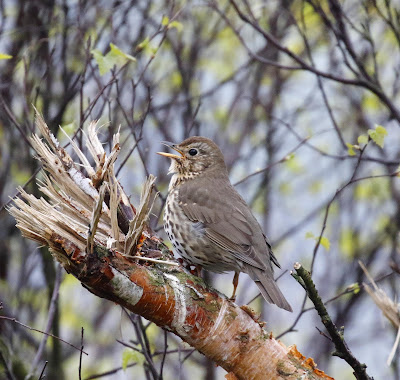 |
| Song Thrush |
Behind the cottage lies Glen Catacol with its mountain ranges and resident Golden Eagles. There is also a small Sand Martin colony here, by the river and recently established when the sandy earth gave way on a high embankment and allowed the birds to excavate nesting holes.
 |
| The track through the gorse leading to Glen Catacol |
 |
| Glen Catacol with the Glen Catacol river. Golden Eagles breed on the mountain on the left |
For once the adjective idyllic was no exaggeration. The cottage and Catacol had the lot and I did not want to leave. Ever.
We were able to, and did, watch Otters, Great Northern Divers, Black Guillemots and Gannets from our bedroom window, we were that close to the sea. Indeed we were so close that in the evening, sitting in the front garden with a glass of wine and the sun setting over the Kintyre Peninsula we could watch the Gannets, that came from nearby Ailsa Craig, spectacularly diving for fish in Kilbrannan Sound, often so close to shore you could hear the thuds as they hit the water in an explosion of spray and at incredible speed. The small road between us and the shore catered for no more than ten cars an hour but in the early morning and evening was entirely deserted so we could and often did, walk along the road without concern.
Catacol is also home to the Catacol Whitebeam which is a hybrid of the native Rowan and the Cut leaved Whitebeam and of which there is only one live specimen left in the world growing in a remote part of the Isle of Arran. Together with Wood's Cycad from South Africa, of which there is also only one known specimen, the Catacol Whitebeam is the rarest tree in the world.
Rather than go through a day by day account I submit for your delictation some of the highlights of this magical week.
Great Northern Diver
For the entire week an adult summer plumaged Great Northern Diver spent its time in Catacol Bay, coming close to the shore when the tide was high.
 |
| Catacol Bay with Catacol village in the distance and the Glen Catacol river flowing into the sea in the foreground |
Everything about the diver's appearance infers bulk. The head and bill are huge, the business end of the bird and they seem especially large when it submerges its body so the head and thick neck appear to be separated from its long broad body. The comparison with a surfaced submarine is inescapable on seeing this supremely aquatic bird that never comes to land apart from a short time when it has a nest right by the water's edge.
 |
| Great Northern Diver |
The Great Northern was obviously put out as it remained vigilant and suspicious about the possibility of the smaller divers returning. Then another diver appeared, floating into the bay with the tide.What would happen now? Would there be a repeat of the underwater attack but no, the Great Northern remained calm.The other diver was a second calendar year Great Northern, in immature plumage as it will not breed this year and the two swam up close to each other. Obviously the younger non breeding diver was considered not to be a threat and was tolerated. They swam with each other for a while and then separated and the younger diver disappeared in a series of dives out into the sound.
It will surely not be long now before the adult Great Northern departs for its breeding grounds in Iceland or maybe even Greenland.
At least five pairs of these birds are breeding in and around Catacol, utilising the large boulders on the shore into which to creep and nest. Unlike their relative the Common Guillemot they are not so gregarious, preferring to remain in pairs
 |
Black Guillemots
|
It would appear that it was still early in their breeding cycle. I watched a pair mating on a rock but there was little sign any were yet seriously nesting as every day they were out on the sea or sat on their favourite rock. Later in early May the female will lay an egg in a hidden and secluded place in the large rocks on the shoreline.
Otter
Catacol Bay is as good a place as any to see Otters on Arran but for the first few days of our stay we failed to see any, not that we were looking that hard. This was rectified by getting up at 6am one day and wandering along the deserted road and checking the adjacent shoreline and sea.
I scanned the sea and saw a dark blob surfacing some way behind us. At that point I could not be sure it was not the Common Seal which we had seen regularly in the bay. It came closer and surely that was a tail as well as a head I saw pointing out of the water.
The mysterious creature came ever closer in a series of dives and eventually was near enough to see it was definitely an Otter and a big one at that. A dog Otter. It was swimming strongly and diving at regular intervals, progressing ever southwards parallel to the shore.
We jumped in the car and followed on the road which hugs the shoreline, stopping on the grass verge every so often, anticipating where the otter would next surface. Sometimes it would surface with prey which was usually a crab and which it would hold in its front paws and eat whilst floating upright and bobbing in the water, then it would turn and swim for a short distance before diving again.
Often it would surface with nothing and then would swim for another short stretch before diving once more.We followed it for a mile along the road until it came into the shore and disappeared into some large rocks where presumably it had its holt.
We reflected on the general fondness with which Otters are regarded viz Tarka but this beast did not engender such feelings. It was too big to have any cuddle factor. Its head large, square and dare I say it almost ugly with formidable teeth. A lone killer cruising his domain.
The next day in the hope of seeing this otter again I got up even earlier at 5.30am leaving Mrs U fast asleep.I walked across the road and scanned the stony beach and from the corner of my eye caught a movement by a small slipway. Aha! I looked harder but there was nothing. Strange, I was certain I had seen another Otter but maybe I was still a little drowsy and had been mistaken. I stood motionless for a full ten minutes and then there it was again, a small shape and disturbance in the water by the slipway and this time there was no mistake. It was another Otter but much smaller than the one yesterday. It was fishing around where the end of the slipway went below the sea and was diving and remaining submerged for some time. It was tiny compared to the dog Otter we had seen yesterday so presumably was a female or young Otter. So small it was difficult sometimes to make it out as just the tip of its head and tail surfaced before submerging again.
It caught a large crab which it decided to bring onto the shore and it crunched it up amongst the rocks and then went back into the sea to recommence its search for food.
It was little inclined to move away from the vicinity of the slipway possibly because the fishing was good there. Eventually it swam further out to sea, dived and after some time surfaced with a large fish, so large it was almost the same length as the Otter. The fish it had caught was a dogfish and it took an age for the Otter to struggle with it, tugging the reluctant and writhing fish through the water to the shore but finally it managed to do so. I tried to call Mrs U on my phone to tell her to look out of the window as she would get a grandstand view of the Otter but all I got was a voice mail. I could not run across the road to the house as the Otter would see me and surely depart. I sent a text more in hope than expectation, hoping my wife might see it in time before the Otter disappeared.
Meantime the Otter seemed somewhat perplexed at how to deal with the fish,, now flapping half in and half out of the water. The Otter commenced gnawing at the fish's head but the fish continued resisting and after periodic bites at the wriggling fish the Otter gave up what it took to be an unequal struggle and wandered around while the fish, which looked mortally wounded, with half its head eaten, lay in the seaweed and rocks. Then the Otter decided it would have another go and returned to the fish and chewed yet more of the unfortunate fish's head. It seemed totally uninterested in the fleshy body. Yet again, after a few minutes, it abandoned the fish. Maybe it was full and its hunger satisfied or it just fancied the head of the fish, most of which was now eaten? However the Otter returned for one more go, again chewing what remained of the dogfish's head and then abandoned the fish which, still minus most of its head, somewhat amazingly, groggily swam off, no doubt to succumb. Later I reflected that I had watched quite a grisly sight but this was nature red in tooth and claw and no doubt a daily occurrence. However at the time none of this troubled me, so excited was I at seeing all this played out just a few yards in front of me, and for such an extended period.
 |
| The Otter eating the Dogfish |
The Otter looking a little non plussed wandered around for quite some time, snuffling amongst the rocks and seaweed looking for the now departed half dead fish, so maybe it was a young and inexperienced Otter. It gave up and made off again into the sea and came back to the shore with yet another crab which was crunched up with some gusto.
For all this time I had been within twenty metres of the Otter, hardly daring to move, hidden behind a convenient clump of gorse and by now had been watching it for all of forty minutes. I did notice the Otter was definitely aware of the noise of the camera shutter as I fired off volleys of shots to record this, for me, unique encounter.The Otter would stop what it was doing every so often, to stare in my direction. I would remain motionless and not use the camera and after a questioning look the Otter would carry on untroubled.
 |
| The Otter looking in my direction alerted by the camera clicks |
The last I saw of the Otter was it running over some rocks that were some way off and forming a small island in the receding tide, scaring some Black Guillemots in the process. I decided not to pursue it further and this fabulous experience came to an end.
Later that day we chatted to a local lady who lived in one of the cottages a few doors down from us who told us she recently had encountered two otter cubs which had crossed the road to play in her front garden.
Red breasted Merganser
Arran plays host to nationally significant numbers of Red breasted Mergansers and a small number of them were regularly to be seen in Catacol Bay. They appeared to be mainly drakes and they had a preference for fishing at the mouth of the Glen Catacol river that runs down from the glen and into Catacol Bay.
They have a 'devil may care' look about them as if they might at any moment go off script. Maybe its the shaggy feathering on the back of their head which makes them look as if they have just been roused from sleep or maybe its the wild look in their red eye and that stiletto of a bill.
I made an effort to go to the river mouth one early morning to sneak through the gorse and get a picture of one of the drakes. I emerged from the gorse and stood partially concealed in a shallow seaweed strewn gully by the river. It worked like a charm and a drake came very close before it saw me but even then it only flew a few metres from me out to sea. A sure sign they are not persecuted here.
Brown Hare
In an extensive stand of gorse, which at this time of year is a profusion of golden yellow flowers overflowing the green spiky stems, hid a couple of Brown Hares. They would venture out onto the short grass between the gorse and the sea shore. Lolloping and frolicking about, their hind legs can be seen to be extraordinarily long, being thrust well forward of their front legs as they move across the ground but these same long legs are their saviour as it these that they rely on to give them the speed to outrun any danger.
They were sniffing at various spots on the rocky shore seeking I know not what and it certainly looked a strange habitat for a hare. Their coats were a warm ginger brown, a rich earth colour for an animal that covets the bare ground which acts as their home, for they have no burrow. The hairs on their backs were smudged darker almost black
The hares were circumspect about being in such a location probably because their view was restricted and foreshortened by the gorse. These are creatures of wide fields and open spaces where they can see potential danger coming from a great distance, so it was unclear to me why they were favouring the gorse but I took full advantage of the opportunity to get close to them, using the car as a mobile hide
Their large and bulbous hazel coloured eyes seem slightly too big for their eye sockets and protrude from their head but again they use eyesight as one of their defences to become aware of a potential threat and their long ears constantly move independently as they listen for danger or unfamiliar sounds.
So there we have it. Some of the wildlife highlights from The Isle of Arran.
On our way to the ferry on the last morning of our stay we went across the island on 'The String' a small road that crosses the island from east to west, ascending high onto moorland between the mountains. As we drove out of Brodick and started climbing, the huge mountains surrounding Glen Rosa climbed to the sky on our right. The blue sunlit sky looked inviting and Mrs U announced she could see two large black silhouettes far up in the firmament to our right as I drove. They must be eagles surely and finding a pull in of sorts by a field gate we rapidly got out of the car and looked skywards with the bins. Indeed they were eagles, Golden Eagles, a pair, circling around close to each other, so close you could see the difference in size between the larger female and the smaller male. They circled above us, high in the sky, their silhouettes distinct now against a huge white cloud and then the male began displaying, swooping down with closed wings in a plummeting dive to pull out and soar upwards, again to circle with the female and then again and again he dived with wings held close to his body before pulling up and rocketing back upwards on the wind currents. It was spectacular stuff and a fitting farewell to The Isle of Arran.













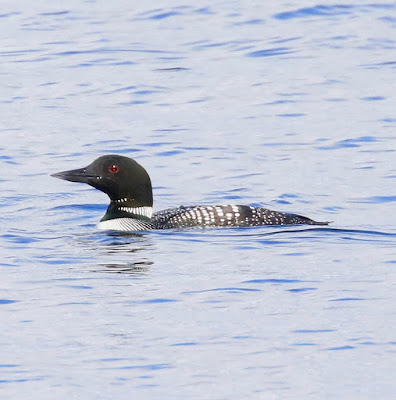






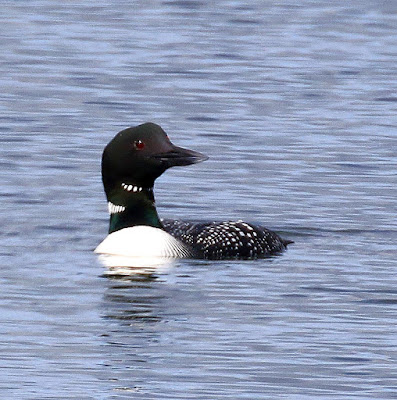










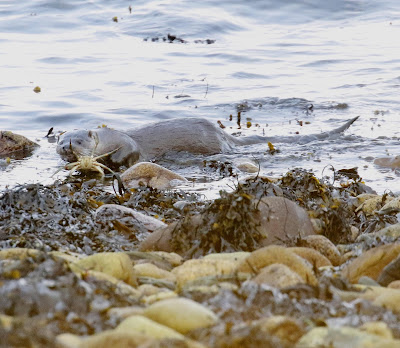



















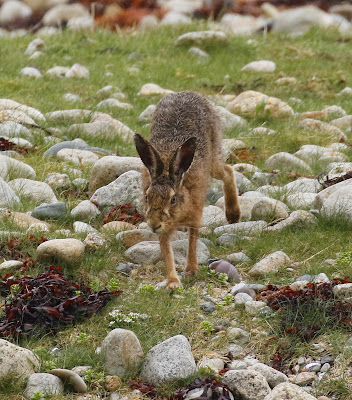


Superb - I'm surprised you didn't just stay & squat in the cottage! ;o)
ReplyDelete